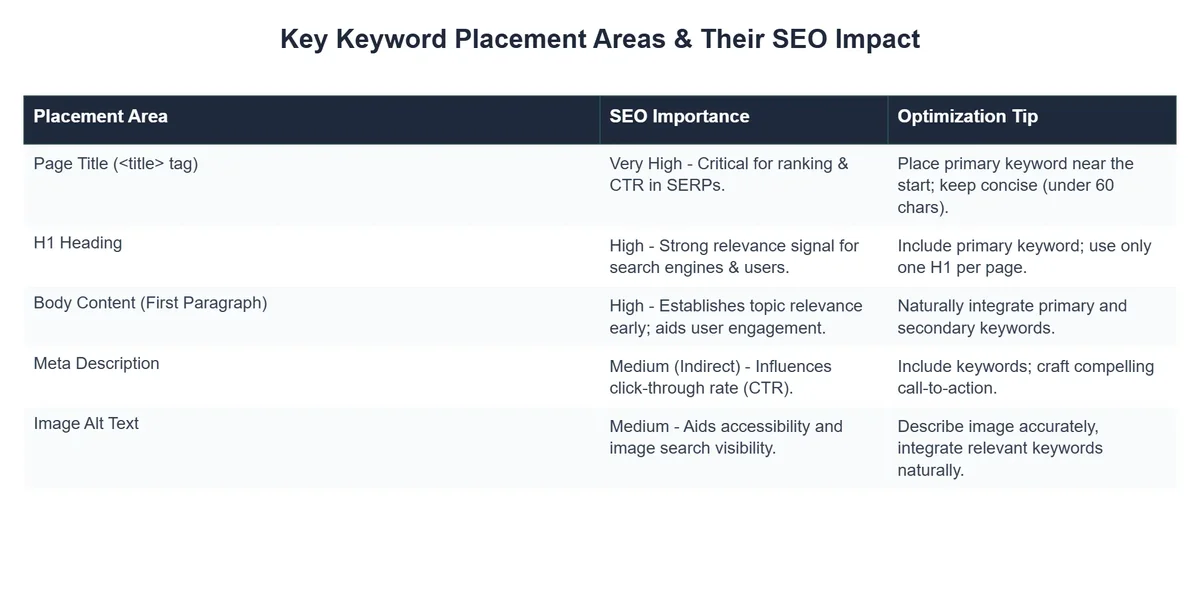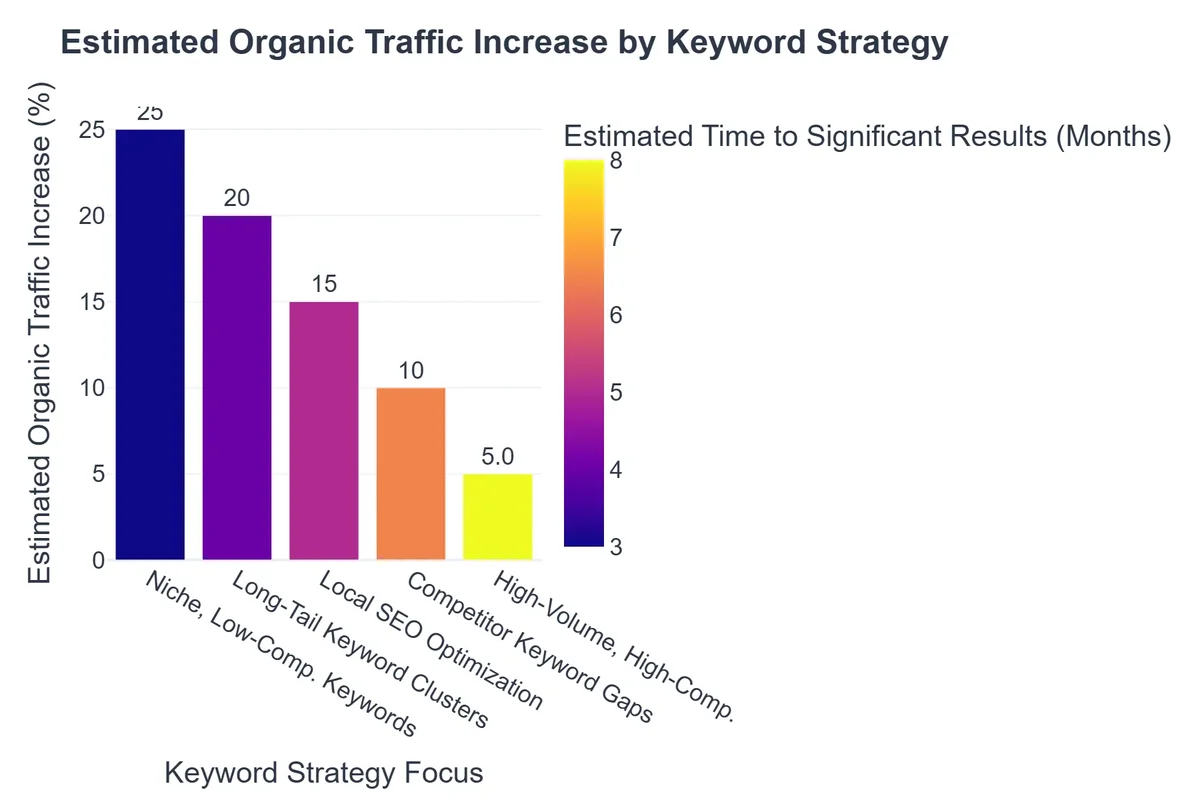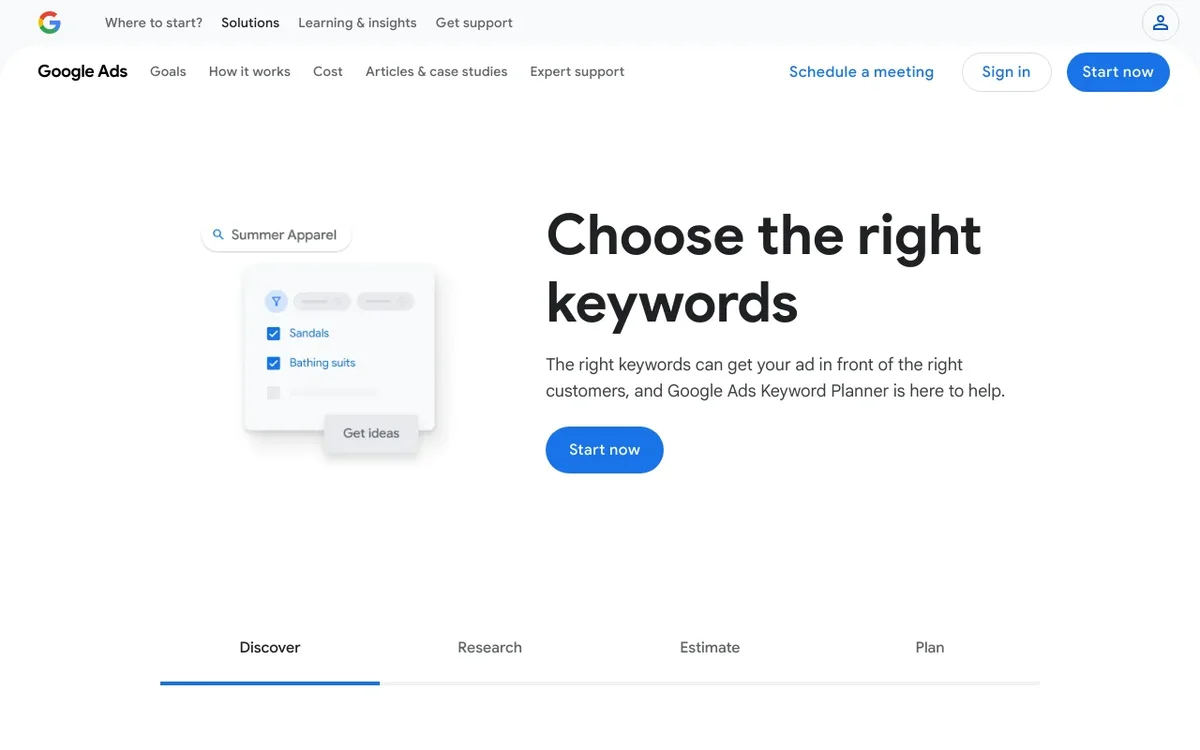In the dynamic world of digital marketing, achieving high search engine rankings is paramount for visibility and business growth. At the heart of this endeavor lies keyword optimization – a fundamental practice that bridges the gap between what people search for and the content you provide. It’s more than just stuffing keywords; it’s a strategic process of understanding your audience, identifying relevant terms, and seamlessly integrating them into your web content to improve search engine visibility and drive targeted organic traffic.
💡 Key Takeaways
- Effective keyword research is the cornerstone of any successful SEO strategy, revealing user intent and search volume.
- Strategic keyword placement throughout your content, including title tags and headings, significantly impacts ranking potential.
- Beyond density, focus on keyword relevance, topical authority, and user experience for sustainable SEO gains.
- Regularly analyze keyword performance and adapt your strategy to evolving search trends and algorithm updates.
“Keyword optimization isn’t just about stuffing words; it’s about understanding the user’s journey and crafting content that precisely answers their queries. It’s the bridge between intent and visibility.”
— Liam Carter, Senior SEO Strategist
This ultimate guide delves deep into the nuances of keyword optimization for SEO, offering practical insights and actionable strategies designed to help you rank higher on search engine results pages (SERPs). Whether you’re a seasoned SEO professional or just beginning to learn about SEO and keyword optimization, this comprehensive resource will equip you with the knowledge to master this critical discipline.
In This Article
- — 💡 Key Takeaways
- → Understanding the Core of Keyword Optimization
- — What is Keyword Optimization?
- — Why is Keyword Optimization Crucial for SEO?
- — The Evolution of Keyword Strategy
- → Comprehensive Keyword Research: The Foundation
- — Identifying Your Target Audience’s Language
- — Leveraging Keyword Research Tools
- — Long-Tail Keywords vs. Short-Tail Keywords
- — Competitor Keyword Analysis
- → On-Page Keyword Optimization Techniques
- — Strategic Placement of Keywords
- — Keyword Density: A Balanced Approach
- — Semantic SEO and Latent Semantic Indexing (LSI) Keywords
- → Beyond On-Page: Advanced Keyword Optimization Strategies
- — User Intent and Keyword Grouping
- — Local SEO Keyword Optimization
- — YouTube Keyword Optimization
- — Amazon Keyword Optimization
- → Measuring and Refining Your Keyword Strategy
- — Tracking Keyword Performance
- — Adapting to Algorithm Changes
- — Continuous Keyword Research and Content Refresh
- → Conclusion
Understanding the Core of Keyword Optimization
Before diving into advanced tactics, it’s crucial to grasp the foundational concepts of keyword optimization and its indispensable role in modern SEO.
What is Keyword Optimization?
Keyword optimization is the process of researching, analyzing, and selecting the best keywords to target, and then strategically incorporating them into your website’s content, meta tags, URLs, and other elements to improve its ranking for those keywords in search engines. It’s about making your content as discoverable as possible for the terms your target audience uses.
Why is Keyword Optimization Crucial for SEO?
Keywords are the building blocks of search. They tell search engines what your content is about and help connect users to the information they seek. Without proper keyword optimization, even the most valuable content might remain undiscovered. It’s essential for:
- Increased Visibility: Ranking higher means more people see your website.
- Targeted Traffic: Attracting users who are actively searching for what you offer.
- Improved User Experience: Delivering content that directly answers user queries.
- Competitive Edge: Outperforming competitors who neglect their keyword strategy.
The Evolution of Keyword Strategy
In the early days of SEO, keyword optimization often meant keyword stuffing – unnaturally repeating terms to manipulate rankings. However, search engines, particularly Google, have become far more sophisticated. Today’s algorithms prioritize user intent, content quality, and semantic relevance. This shift means that effective SEO keyword optimization is less about quantity and more about context, natural language, and truly answering user queries. This also means that a holistic approach to SEO, including technical SEO, backlinks, and user experience, must complement your keyword efforts.

Comprehensive Keyword Research: The Foundation
Effective keyword optimization begins with meticulous keyword research. This phase involves identifying the terms your target audience uses when searching for products, services, or information related to your niche.
Identifying Your Target Audience’s Language
Before touching any tool, put yourself in your audience’s shoes. What problems are they trying to solve? What questions do they have? Consider their demographics, psychographics, and how they phrase their searches. Brainstorming initial seed keywords based on your understanding of your business and customers is an excellent starting point.
Leveraging Keyword Research Tools
Once you have seed keywords, a good keyword optimization tool becomes indispensable. These tools provide data on search volume, competition, keyword difficulty, and related terms.
#1 Google Keyword Planner
Best for: Best for small businesses and digital marketers seeking free, foundational keyword research directly from Google.
- ✔Generous free plan accessible to anyone with a Google account, offering essential keyword data.
- ✔Powerful, native integration with the Google Ads ecosystem for seamless campaign planning.
- ✔Authoritative data source directly from Google, ensuring highly accurate and relevant keyword insights.
#2 Ahrefs Keywords Explorer
Best for: Best for SEO professionals, content marketers, and digital agencies seeking comprehensive keyword research and competitive insights.
- ✔Extensive and regularly updated keyword database with advanced metrics like clicks, return rate, and parent topic.
- ✔Intuitive and well-organized user interface that makes complex data digestible and actionable.
- ✔Seamless integration within the broader Ahrefs platform, enhancing its power for holistic SEO analysis.
#3 SEMrush Keyword Magic Tool
Best for: SEO professionals, content marketers, and digital marketing agencies seeking comprehensive and actionable keyword insights for their strategies.
- ✔Access to one of the largest and most regularly updated keyword databases, enabling extensive and deep research.
- ✔Intuitive and well-structured user interface that simplifies complex keyword analysis and filtering for users of all skill levels.
- ✔Seamless integration with other SEMrush tools, allowing for a cohesive and efficient SEO workflow across different modules.
- Google Keyword Planner: This is an excellent Google-provided keyword optimization tool free to use, primarily for advertisers but highly valuable for SEOs. It offers insights into search volume trends, competition levels for paid ads, and keyword ideas based on your seed terms or website URLs. It’s particularly useful for Google keyword optimization efforts.
- Ahrefs Keywords Explorer: A powerful premium tool that provides extensive data. It allows you to discover thousands of keyword ideas, analyze their difficulty, traffic potential, and SERP features. You can also see what keywords your competitors rank for and identify content gaps.
- SEMrush Keyword Magic Tool: Another industry-leading premium tool, the SEMrush Keyword Magic Tool is renowned for its vast keyword database and sophisticated filtering options. It enables users to uncover long-tail keywords, analyze keyword groups, and identify questions related to a topic, making it a comprehensive solution for keyword research and analysis.
When conducting website keyword analysis, remember to look beyond just high search volume. Evaluate keyword difficulty, relevance, and your ability to create truly superior content for that query.
Long-Tail Keywords vs. Short-Tail Keywords
- Short-Tail Keywords (Head Terms): These are broad, often one or two words (e.g., “SEO,” “coffee machine”). They have high search volume but are highly competitive and less specific in user intent.
- Long-Tail Keywords: These are longer, more specific phrases (e.g., “best espresso machine for beginners,” “how to do keyword optimization for small business”). They have lower search volume but much higher conversion rates due to their specificity and clearer user intent. Focusing on a mix of both, with a strong emphasis on long-tail for easier wins, is often the most effective strategy.
Competitor Keyword Analysis
Analyzing your competitors’ keyword strategies can reveal valuable insights. Tools like Ahrefs and SEMrush allow you to see which keywords your competitors rank for, their top-performing content, and their estimated organic traffic. This intelligence can help you identify overlooked opportunities or validate keyword ideas you’ve already considered.
On-Page Keyword Optimization Techniques
Once you’ve identified your target keywords, the next crucial step is to integrate them effectively into your website’s pages. This is the essence of on page keyword optimization.
Keyword Optimization for SEO: Advantages & Disadvantages
Pros
- ✔Boosts organic search rankings and visibility.
- ✔Increases relevant organic traffic to your site.
- ✔Helps align content with user search intent.
- ✔Provides a structured approach to content creation.
Cons
- ✖Risk of keyword stuffing and potential SEO penalties.
- ✖Requires continuous research and adaptation to algorithm changes.
- ✖Can sometimes lead to less natural-sounding content.
- ✖Time-consuming with no immediate guaranteed results.
Strategic Placement of Keywords
Where you place your keywords matters significantly for search engine understanding and user experience:
- Title Tags and Meta Descriptions: These are your prime real estate in SERPs. Include your primary keyword in the title tag, preferably near the beginning, and naturally incorporate it into the meta description to encourage clicks.
- H1 Headings: Your H1 heading is typically your page’s main title. It should contain your primary keyword and accurately reflect the content of the page.
- Body Content:
- First Paragraph: Place your primary keyword in the first 100-150 words of your content.
- Subheadings (H2, H3, etc.): Use keywords and variations naturally in your subheadings to break up content and signal topic relevance.
- Throughout the Content: Distribute your main keyword and related secondary keywords naturally throughout the body text. Focus on readability and providing value, not keyword count.
- Image Alt Text: Describe images using relevant keywords. This helps search engines understand the image content and can improve image search rankings.
- URL Structure: Keep URLs short, descriptive, and include your primary keyword where logical. For example,
www.example.com/keyword-optimization-guide.
Keyword Density: A Balanced Approach
Gone are the days when a specific keyword density percentage was considered optimal. Today, the focus is on natural language and readability. Instead of aiming for a fixed percentage, ensure your keywords appear naturally and contextually throughout your content. Over-optimizing or “stuffing” keywords can lead to penalties from search engines and negatively impact user experience.
Semantic SEO and Latent Semantic Indexing (LSI) Keywords
Modern search engines understand the context and relationships between words. Semantic SEO involves optimizing for topics and concepts rather than just individual keywords. LSI keywords are terms that are semantically related to your primary keyword, even if they don’t contain the exact phrase. For example, if your primary keyword is “coffee machine,” LSI keywords might include “espresso maker,” “brewing methods,” “barista tools,” or “grind settings.” Incorporating LSI keywords naturally enriches your content, helps search engines understand its depth, and can improve your rankings for a wider range of related queries.
Beyond On-Page: Advanced Keyword Optimization Strategies
While on-page optimization is crucial, a holistic keyword strategy extends beyond the confines of a single page.
User Intent and Keyword Grouping
Understanding user intent is paramount. Are users looking for information (informational intent), trying to buy something (transactional intent), or navigating to a specific site (navigational intent)? Grouping keywords by intent allows you to create highly targeted content that satisfies specific user needs, leading to higher engagement and better rankings.
Local SEO Keyword Optimization
For businesses with a physical location or serving a specific geographical area, local keyword optimization is vital. This involves targeting keywords with local modifiers (e.g., “best coffee shop London,” “plumber near me”). Optimizing your Google My Business profile, building local citations, and encouraging local reviews are also key components.

YouTube Keyword Optimization
Video content is booming, and YouTube keyword optimization is essential for creators. This includes:
- Video Titles and Descriptions: Incorporate your primary keywords and related terms.
- Tags: Use relevant keywords and variations to help YouTube understand your video’s content.
- Transcripts and Closed Captions: Provide accurate text versions of your video’s dialogue, as this is indexed by YouTube and Google.
- Thumbnails and Engagement: While not direct keyword factors, engaging thumbnails and high viewer retention signal video quality, which can indirectly boost rankings.
Amazon Keyword Optimization
For e-commerce businesses, Amazon keyword optimization is a distinct discipline. Amazon’s A9 algorithm differs from Google’s, focusing heavily on conversion rates and sales velocity. Key areas include:
- Product Titles: Include primary keywords, brand name, and key product features.
- Bullet Points: Use keywords to highlight benefits and features.
- Product Description: Write compelling copy that incorporates keywords naturally.
- Backend Search Terms: Amazon allows you to enter “hidden” search terms in the backend of your product listing.
- Customer Reviews: While not directly keyword input, reviews often contain keywords that Amazon’s algorithm picks up.
Measuring and Refining Your Keyword Strategy
Keyword optimization is not a set-it-and-forget-it task. It requires continuous monitoring, analysis, and adaptation.
Tracking Keyword Performance
Regularly monitor your keyword rankings using tools like Google Search Console, Ahrefs, or SEMrush. Pay attention to:
- Ranking Position: How high are you appearing for your target keywords?
- Organic Traffic: How much traffic are these keywords driving to your site?
- Conversions: Are these keywords leading to desired actions (sales, leads, sign-ups)?
- Click-Through Rate (CTR): Are your titles and descriptions compelling enough to encourage clicks from the SERP?
Adapting to Algorithm Changes
Search engine algorithms are constantly evolving. What works today might not work tomorrow. Stay informed about major algorithm updates from Google and other platforms. Be prepared to adjust your keyword strategy to align with new best practices, always prioritizing user experience and valuable content.
Continuous Keyword Research and Content Refresh
The language people use to search changes over time, and new trends emerge. Regularly revisit your keyword research to discover new opportunities, identify declining terms, and keep your content fresh and relevant. Updating existing content with new insights and optimized keywords can significantly boost its performance.
Recommended Video
Conclusion
Mastering keyword optimization is a continuous journey that forms the backbone of any successful SEO strategy. By thoroughly researching your audience’s search habits, strategically integrating relevant keywords into your content, and consistently monitoring your performance, you can significantly improve your search engine rankings and attract highly qualified organic traffic. Remember, effective seo and keyword optimization is about providing genuine value to your users, aligned with their search intent, which naturally leads to higher visibility and long-term success in the digital landscape.
Frequently Asked Questions
What is keyword optimization in SEO?
Keyword optimization is the process of researching, analyzing, and selecting the best keywords to target and then strategically placing them within your content and website to improve search engine rankings and attract relevant organic traffic.
How often should I update my keyword strategy?
Keyword strategies should be reviewed and updated regularly, ideally quarterly or bi-annually, to adapt to changing search trends, new competitors, and evolving algorithm updates.
Can keyword stuffing hurt my SEO?
Yes, keyword stuffing, which is the excessive and unnatural repetition of keywords, is a black-hat SEO tactic that can severely harm your rankings and lead to penalties from search engines like Google.
What are long-tail keywords?
Long-tail keywords are longer, more specific phrases (typically three or more words) that users search for, often indicating higher purchase intent or a very specific information need, and they usually have lower search volume but higher conversion rates.
Google Keyword Planner
Ready to take the next step? See how Google Keyword Planner can help you achieve your goals.








